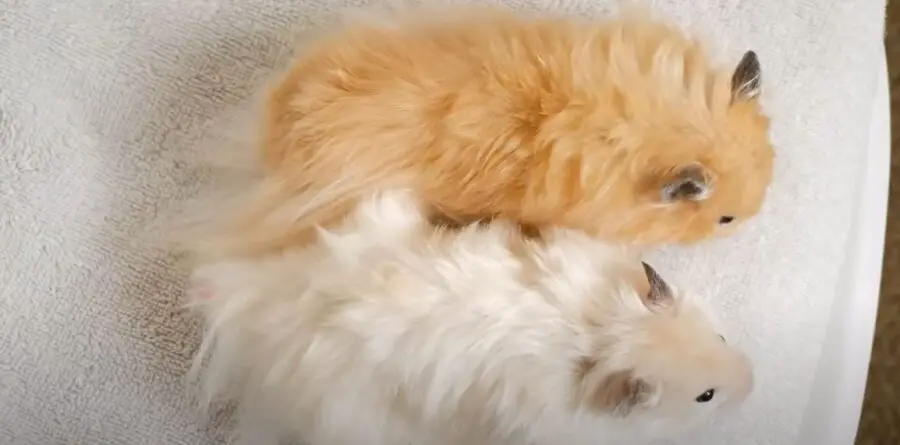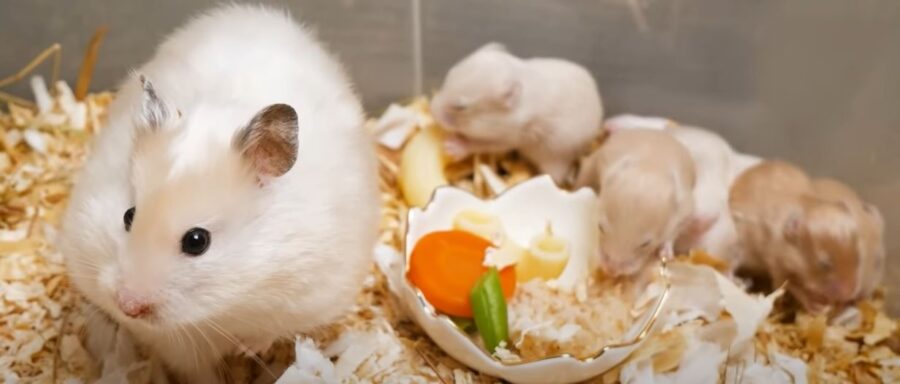Sometimes I think my eyes are fooling me. Do hamsters change color? Am I seeing things or is there a scientific reason behind this to back me up?
Is my hamster changing color out of sickness or poor health? Why is my hamster getting lighter in color?
In this article, we will explore the topic of hamster hues and find out, “Do hamsters change color?”
Do Hamsters Change Color?
Sure. Hamster may go through slight color changes from birth as they mature into adults. There are several more reasons that can cause a hamster to change color ranging from:
- Too much light
- Lack of light
- Changes in seasons
- Illness (wet tail)
- Old age (color fading and some hair loss)
Stress could also be a factor. Make sure your hamster is well nourished, not scared of possible threats and praised often for being a perfect little pocket pet for you and your household.

Why Is My Hamster Turning Brown?
The most common color changes in the hamsters are when they turn gray or brown. A hamster that is slowly aging can be noticed by looking at the color of its hair or fur.
Browning usually occurs during warmer weather or hotter seasons as well. A winter white hamster can shed white fur after the winter season has passed.
You might be noticing a graying or browning of color during this time. There is no reason for a winter white hamster to remain this color to camouflage against the snow since there is none of that in your home and no potential predators either.
Why Is My Hamster Turning Black?
It would be concerning sight to see your hamster turning black. Most of the time, hamsters turn lighter in color or brown.
If you see that your hamster’s fur is turning darker or blackening, there could be a health condition. You might need to visit the vet. Here are some reasons why hamster can turn black:
- black tail
- wet tail
- sticky rear end
- black patches
- diarrhea stains
Some of these issues are very stressful and frustrating to deal with. You might have a sick hamster that needs medical treatment.
Wet tail disease could be fatal without any treatment. Observe your hamster for the next day or two and if you see other symptoms such as a lack of appetite or lethargy, it’s time to visit the vet.
Why Is My Hamster Turning Yellow?
The scent glands on a hamster or urine stains can cause color changes that look yellow or patchy on a hamster. Make sure that your hamster is cleaned and check once more to see if his yellow stain are permanent or just temporary.
Genetic color changes can occur or the oil that secretes from scent glands could cause color changes that look yellow. This happens more often to male hamsters than females.
Why Is My Hamster Getting Lighter in Color?
A hamster’s fur coat that appears lighter is probably also getting thinner at the same time. This is a usual occurrence when a hamster starts to age. You may also start notice patches of baldness.
Do not be alarmed and accept the fact that a hamster’s life span is much shorter than ours. The changes in light color will first appear subtly and then you will notice thinning or dropping of fur.
If you also notice that your hamster is getting a lot of sunlight recently, the fur could also appear lighter.

Is It Normal For Hamsters To Change Color?
Yes. It’s normal for hamsters in the wild to change color more often. Hamsters that are in captivity are normally indoors and do not change color as often.
Syrian hamsters can change from darker colors to slightly whiter when they are out in the winter season to camouflage with the snow.
Hamsters can also change color due to urine stains or wet tail disease. Make sure you check for a bacterial infection that can be treated before it’s too late. Wet tail is the most common bacterial infection that you will notice coupled with lethargy and diarrhea.
Why Is My Hamsters Fur Getting Darker?
In the wild, there are hamsters known as winter white hamsters that camouflage themselves against the snow with their white fur. If your winter white hamster has no need to do this inside the enclosure in your home, there is a good chance that you will notice the darkening of the fur.
This has been reported by many hamster owners in the community that we are all a part of. You may see color changes happening in patches or waves from head to tail.
Why Is My Hamster’s Fur Turning White?
Hamsters naturally turn lighter in color when they are out in the wild around snow. They are trying to blend in with their surroundings. This is an effective survival instinct for hamsters.
A full transition to white may not be expected. You might only see a few patches here and there. It is not common to witness this happening in captive hamsters.
There is no need because there are no potential threats lurking around. Also your hamster is not getting as much sunlight as they would in the wild which would also initiate a lighter color change.

What Is The Rarest Color Of Hamster?
The most rare type of hamster would probably be the albino variety. This is a genetic disorder that causes the lack of pigmentation leading the hamster to become fully white without any other patches of any other colors.
Beige hamsters are the most rare because of the interbreeding between rusty orange hamsters and dark gray hamsters. Since it doesn’t occur too often, beige hamsters do not become prevalent in the hamster world.
They are usually the runt of the litter. You may notice a beige hamster with a kinked tail that looks crooked, but very cute.
Why Syrian Hamster Fur Changing Color?
Syrian hamsters are able to develop color changes that usually start from a darker tone to a lighter one. This happens during the changing of the seasons.
You may notice a Syrian hamster turning slightly whiter in color in the winter where it makes sense to blend in with the prominent color around them.
Snow can camouflage a lighter colored Syrian hamster and keep them safer from the many hungry and desperate predators in colder weather conditions. You may also notice your Syrian hamster looking yellow or dull, but this could be due to urine stains or wet tail disease.
If the color change is odd or unsightly mixed with an added smell that is unfamiliar or uninviting, it’s best to get this checked out by a vet for a possible infection, illness or underlying issue that may need a diagnosis.
What Is a Satin Hamster?
Satin hamsters are desired for their glossy looking for. It may look shiny and very smooth when you touch the fur. It is quite thick and attractive.
Satin hamsters breeding together may not result in this gene being passed over. This is because the satin gene is recessive and you may end up with offspring who produce patchy fur instead of the satin you were wishing to see once more.
Thank you for visiting PocketPetCentral.com for the best information to help you enjoy the life of your pocket pet companion in a fun, safe & healthy way.


